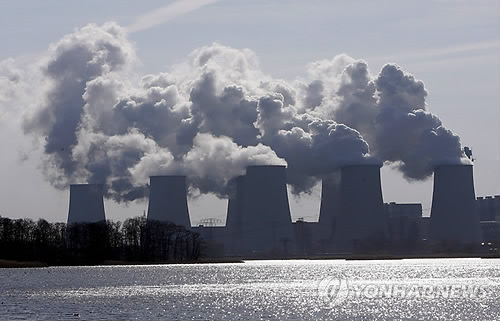Korea mapped out action plans to taper greenhouse gas emissions Tuesday, breaking down reduction targets for energy-intensive sectors in the mid and long terms.
The pangovernmental comprehensive framework, approved by the Cabinet, aims to achieve the country’s goal of cutting carbon emissions by 37 percent, or 315 million metric tons, based on business-as-usual levels. Seoul introduced its voluntary reduction target during a UN climate conference in Paris last December.
“The action plans were formulated in a way that helps to shift the reduction-focused responses to climate change to a fresh paradigm centering on the market and technology ... and strengthen the private sector’s role and promote the acceptability of the policy,” the intra-agency statement said.
The pangovernmental comprehensive framework, approved by the Cabinet, aims to achieve the country’s goal of cutting carbon emissions by 37 percent, or 315 million metric tons, based on business-as-usual levels. Seoul introduced its voluntary reduction target during a UN climate conference in Paris last December.
“The action plans were formulated in a way that helps to shift the reduction-focused responses to climate change to a fresh paradigm centering on the market and technology ... and strengthen the private sector’s role and promote the acceptability of the policy,” the intra-agency statement said.

Under the plan, the government aims to slash 219 million metric tons, or nearly 70 percent of the total reduction goal, from eight areas such as power production, industry and buildings, setting the sectoral target at 25.7 percent below projected levels.
The largest slice would come from electricity generation with 64.5 million metric tons, followed by industry with 56.4 million metric tons, buildings with 35.8 million metric tons and new energy sectors including electric vehicles and energy storage with 282 million metric tons.
Seoul also looks to curb 96 million metric tons through international market mechanisms in line with the Paris climate agreement. It would devise a more detailed blueprint by 2020, saying the overseas reduction plan requires additional global discussions such as on carbon credit trading and funding sources.
Yet mindful of the industry’s unabated jitters over what it calls a side effect on the business environment, the government left room for a future revision, saying it would “adjust and complement” its plans according to the “fast-changing economic conditions” at home and abroad and global climate policy trends.
To ensure a transparent implementation and inclusiveness, the Prime Minister’s Office will take over control from the Environment Ministry to oversee the issue and carry out inspections every five years through a public-private partnership.
As part of efforts to pare the country’s reliance on fossil fuel, the government is seeking to boost incentives for renewable energy and cleaner power plant projects. It intends to raise the share of renewable sources in its portfolio to 7 percent from the existing 6 percent by 2020.
The plan called a cap-and-trade system “key” to meeting the 2030 goal, which it said would expedite industry innovation and environmentally friendly investment while helping to integrate into the future global carbon market.
It pledged to expand funding in the development of 10 climate technologies including solar and fuel cells and conversion of waste gas, while doubling investment in clean energy research to 1.12 trillion won ($957 million) by 202.
Korea is the world’s seventh-largest polluter, with its carbon output in 2013 reaching 572 million metric tons, according to the International Energy Agency. The country’s emissions marked the fastest growth since 1990 among the members of the Organization for Economic Cooperation and Development.
By Shin Hyon-hee (heeshin@heraldcorp.com)
The largest slice would come from electricity generation with 64.5 million metric tons, followed by industry with 56.4 million metric tons, buildings with 35.8 million metric tons and new energy sectors including electric vehicles and energy storage with 282 million metric tons.
Seoul also looks to curb 96 million metric tons through international market mechanisms in line with the Paris climate agreement. It would devise a more detailed blueprint by 2020, saying the overseas reduction plan requires additional global discussions such as on carbon credit trading and funding sources.
Yet mindful of the industry’s unabated jitters over what it calls a side effect on the business environment, the government left room for a future revision, saying it would “adjust and complement” its plans according to the “fast-changing economic conditions” at home and abroad and global climate policy trends.
To ensure a transparent implementation and inclusiveness, the Prime Minister’s Office will take over control from the Environment Ministry to oversee the issue and carry out inspections every five years through a public-private partnership.
As part of efforts to pare the country’s reliance on fossil fuel, the government is seeking to boost incentives for renewable energy and cleaner power plant projects. It intends to raise the share of renewable sources in its portfolio to 7 percent from the existing 6 percent by 2020.
The plan called a cap-and-trade system “key” to meeting the 2030 goal, which it said would expedite industry innovation and environmentally friendly investment while helping to integrate into the future global carbon market.
It pledged to expand funding in the development of 10 climate technologies including solar and fuel cells and conversion of waste gas, while doubling investment in clean energy research to 1.12 trillion won ($957 million) by 202.
Korea is the world’s seventh-largest polluter, with its carbon output in 2013 reaching 572 million metric tons, according to the International Energy Agency. The country’s emissions marked the fastest growth since 1990 among the members of the Organization for Economic Cooperation and Development.
By Shin Hyon-hee (heeshin@heraldcorp.com)


















![[Today’s K-pop] Treasure to publish magazine for debut anniversary](http://res.heraldm.com/phpwas/restmb_idxmake.php?idx=642&simg=/content/image/2024/07/26/20240726050551_0.jpg&u=)